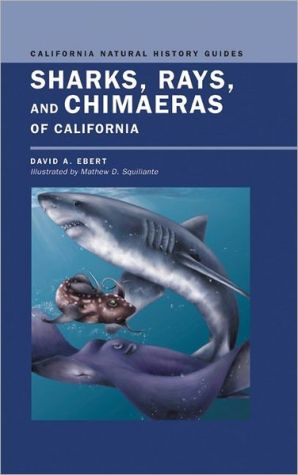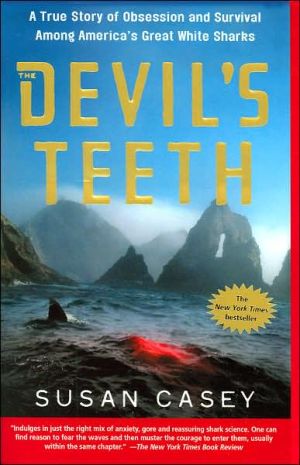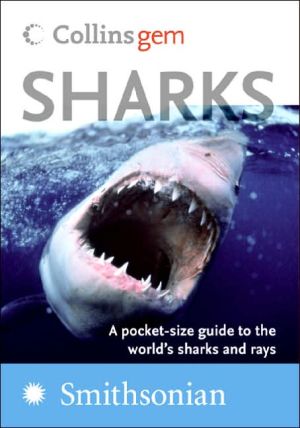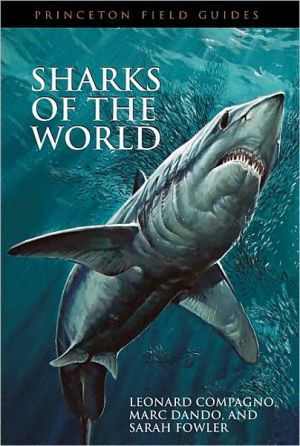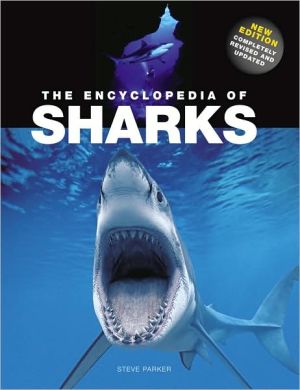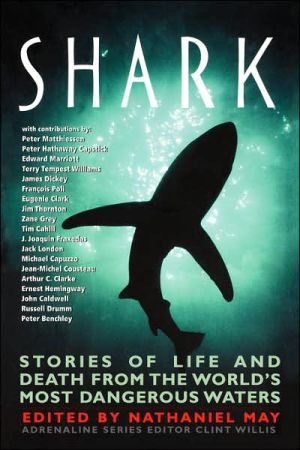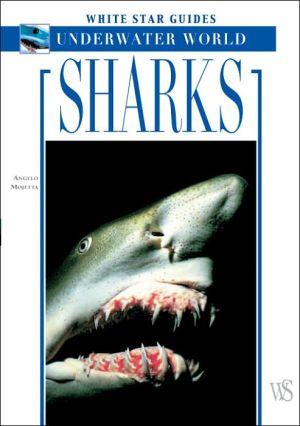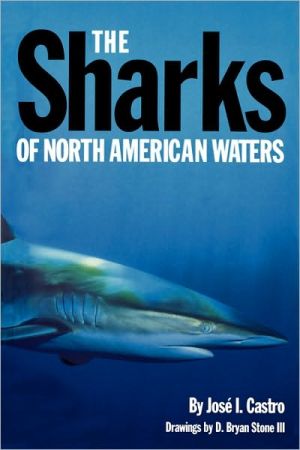Sharks, Rays, and Chimaeras of California
This guide is the only complete reference to the sharks, rays, and chimaeras found in California's waters— from the intertidal zone to 500 miles offshore.\ Species accounts give information on habitat and range, natural history, interactions with humans, nomenclature, and further references\ 68 beautiful color illustrations show each shark, ray, and chimaera; accompanying line drawings highlight differences in teeth, underside of the head, and egg cases\ Includes information on the...
Search in google:
"Ebert has herein assembled an enormous body of knowledge about California's 43 shark species ranging from shark and human behavior to taxonomic minutiae, along with up-to-date explanations of their ecology, status and fisheries. More importantly, his Herculean effort includes the often-overlooked 25 species of skates, rays and chimaeras. That, along with the fine illustrations of Mat Squillante, should answer any question that a student, diver, natural history buff, or recreational or commercial fisher might ask."—John E. McCosker, coauthor of Great White Shark"The timing of this publication is ideal given the status of some of California's elasmobranch populations and the need for a deeper understanding of their biology, ecology, and fishery management. The book is a comprehensive treatment—if one wants to find out the latest information on any species of shark or ray off California, this is the place to go. An outstanding work!"—Gregor M. Cailliet, Professor, Moss Landing Marine Laboratories, and Director, Pacific Shark Research Center
SHARKS, RAYS, AND CHIMAERAS OF CALIFORNIA\ \ By DAVID A EBERT \ The University of California Press\ Regents of the University of California\ All right reserved.\ ISBN: 0-520-22265-2 \ \ \ Introduction\ don't realize how colorful many of these species are. Geographically the guide reaches from the innermost shallow bays and estuaries to 500 miles offshore. \ The introductory sections on chondrichthyan biology, ecology, and diversity are intended only as a brief overview, as other contemporary authors have treated these subjects in more detail. The guide is primarily intended to be useful in the field, where users can simply match the illustration to the specimen or work through the identification keys to each species. Once a tentative identification has been made, the reader can turn to the species description and natural history notes.\ California's Marine Environment\ The California coastline (map 1), which extends over 1,100 miles in a north-south direction from the Mexican border (32 degrees N latitude) to the Oregon border (42 degrees N latitude), is composed of three major geographic regions: northern California (the Oregon border to San Francisco), central California (San Francisco to Point Conception), and southern California (Point Conception to the Mexican border). The general flora and fauna shift from warm-temperate water species in the south to cold-temperate water species in the north, whereas the transition of the elasmobranch faunaseems to occur in the central California region, where warm-temperate water species give way to cool-temperate nearshore species. Species such as the Pacific Sleeper Shark, some skates, and the White-spotted Ratfish, which occur in deep water in southern California, occur in relatively shallower water in the northern part of the state.\ The temperature of the water along the California coast is influenced by the California Current, a major surface current that flows north to south, from the Gulf of Alaska, down the coastline to Point Conception, where it veers offshore. The area south of Point Conception where the coastline bends eastward is known as the Southern California Bight and is less affected by the California Current than the waters to the north. The less dominant Davidson Current brings warmer water from the south along the coastline to the north influencing the Southern California Bight and the Channel Islands. A seasonal fluctuation in the movement of these currents combined with strong seasonal winds causes an upwelling of cold, nutrient-rich water along the coast, an effect most prominent in central and northern California during the spring and summer.\ Water temperature is an important factor influencing the distribution of California's cartilaginous fish fauna. The gradient of surface water temperatures ranges from approximately 68 degrees F in the south during summer to about 48 degrees F in the north during winter and spring, with Point Conception being the major area of demarcation. South of Point Conception the water temperature is usually 4 to 11 degrees F warmer than to the north. Temperature changes created by surface winds also occur throughout the water column, forming stratified layers of warm and cold water known as a thermocline.\ The seasonal movement of warm or cool water masses influences the movements of many species of cartilaginous fish. In summer warm water from the Davidson Current pushes north-ward increasing the water temperature, bringing warmer water species into California waters. Conversely, in winter and spring cooler water masses lower the water temperature, bringing cold-temperate species into our waters. Occasionally rapid changes occur in these warm- or cold-water masses, causing a localized mortality in temperature-sensitive populations. Young dead or dying cold-water salmon sharks occasionally wash ashore along the beaches of central and southern California following a rapid increase in water temperature. Warm-water species may also be affected by a rapid cooling of the water.\ California is subject to an unusual phenomenon that at times can dramatically alter weather patterns with an associated increase in water temperature. El Nino (Spanish meaning The Child, in reference to the Christ Child), which occurs every two to seven years for unknown reasons, can range from mild to quite severe, as occurred from 1982 to 1983, when the state experienced intense winter storms. During or immediately preceding an El Nino event at least 16 species of California's known cartilaginous fish fauna were first reported in our waters, including the Pelagic Thresher Shark and Manta Rays (seen around the Channel Islands). Both species are typically found much farther south off Baja and in the Sea of Cortez. As opposed to El Nino, La Nina brings cooler water to our area and thus a more cold-temperate water fauna.\ Oceanographic conditions, especially water temperature, have exhibited major cyclic fluctuations over the past several thousand years, with changes in the average water temperature occurring every few hundred years. Historical evidence indicates that as recently as the mid-1800s the coastal waters of central and southern California rejected an environment that was more warm-temperate to subtropical than is seen today. Conversely, 400 years ago, cold-temperate species now rarely seen south of central California inhabited the coast as far south as the tip of Baja. This may explain why several seemingly cool-temperate species such as the Sevengill Shark and Leopard Shark have apparently isolated populations in the northern Gulf of California.\ Classification of Cartilaginous Fishes\ All living organisms are grouped into a hierarchy of categories from broad down to the most specific. The basic groups, in descending order, are kingdom, phylum, class, order, family, genus, and species (table 1). Each higher level group contains one or more members of the group below it, so a class would contain one or more orders, an order one or more families, and so on down to the species level. A single scientific name is assigned to the members of each group, except at the species level, at which members are given a binomial name (bi meaning two and nomial meaning name). The scientific name is made up of a given genus and species name, both of which are usually italicized or underlined.\ Scientific names are often followed by the name of the person who originally described the family, genus, or species, and the year in which it was first described. If the species was subsequently placed into a different genus, the person's name is put in parentheses. The Sevengill Shark, for example, was originally described by Francois Peron in 1807 as Squalus cepedianus, but was later placed into a new genus, Notorynchus, by William Ayres (1855). Thus, the proper citation is Notorynchus cepedianus (Peron, 1807).\ The person's name and date of description allow researchers to trace the taxonomic history of a specific species to determine whether it was previously described or is undescribed. If two species are found to be the same, the oldest description has precedence over the newer name, which then becomes invalid (commonly referred to as a junior synonym). The species names for many of the cartilaginous fishes from California waters were originally classified under different names in earlier publications.\ In each species account in this guide, the full scientific name appears at the beginning of the nomenclature subsection.\ What Are Cartilaginous Fishes?\ Among the five vertebrate groups, the fishes are the largest and most diverse with over 25,000 species described. By comparison, the other four vertebrate groups-amphibians, reptiles, birds, and mammals-collectively have less than 20,000 known species. The fishes can be subdivided into two distinct groups: those with a bony skeleton, known as the bony fishes or teleosts, and those with a cartilaginous skeleton, referred to as cartilaginous fishes.\ All living sharks, rays, and chimaeras belong to the class Chondrichthyes (Greek, chondro meaning cartilage and ichthos meaning fish), a group of aquatic, gill-breathing, finned vertebrates. In contrast to the bony fishes or class Osteichthyes (Greek, osteos meaning bone and ichthos meaning fish), these fishes have a simplified internal cartilaginous skeleton and lack true bone. Other distinguishing characteristics of the chondrichthyans include fins without bony rays, a true upper and lower jaw, and nostrils on the underside of the head. Their teeth are typically inconspicuous transverse rows or fused tooth plates, and they are continuously being replaced from inside the mouth. Cartilaginous fishes have no bony plates on the head; their scales appear in the form of small, toothlike dermal denticles known as placoid scales; and they have internal fertilization.\ The class Chondrichthyes can be subdivided into two major groups, the large subclass Elasmobranchii (elasmo meaning plates and branchii meaning gills), which includes several groups of fossil sharks and all of the modern living sharks and rays, and the small subclass Holocephali (holo meaning entire and cephali meaning head), which includes all of the chimaeras. The ordinal classification used here follows Compagno (2001) but recognizes that there is still some disagreement among modern systematists (scientists who study the classification of organisms) regarding the definition of these higher groups. There are currently ten recognized orders of "sharks," a term which in the broad sense includes the rays and chimaeras. Eight of these orders comprise the "typical" sharklike fishes while the rays and chimaeras are each in their own order (table 2). For simplicity, the term "shark" will be used when referring to "typical" sharks, the term "ray" when referring to the raylike sharks (order Rajiformes) and the term "chimaera" when referring to the chimaeras (order Chimaeriformes).\ The elasmobranchs are the dominant chondrichthyan group with approximately 56 families representing 96 percent of the species; the remaining 4 percent, which includes three families, are the chimaeras. In higher taxonomic groups (genera and above) the sharks are more diverse than the rays, but among all elasmobranch species there are more rays (57 percent) than sharks (43 percent). Worldwide approximately 988 species of cartilaginous fishes have been described, with another 150 or more awaiting formal description by researchers.\ What Is a Shark?\ Sharks are cartilaginous fishes with a cylindrical or flattened body, five to seven paired gill openings on each side of the head, a large caudal fin, and one or two dorsal fins, with or without erect, immovable spines. The moderate-sized pectoral fins are not attached to the head above the gill openings. An anal fin may be present. Lacking a swim bladder, sharks have a liver that helps them achieve neutral buoyancy.\ What we think of as "typical" sharks are divided into eight major orders, each of which is easily distinguished by specific external characteristics. Of these, the largest group is the ground sharks (order Carcharhiniformes), representing about 24 percent of the shark families and about 55 percent of all shark species (fig. 1). In fact, approximately 24 percent of all elasmobranchs are members of the Carcharhiniformes. Of elasmobranchs only the rays are larger in total number of species with 543. Eight orders of shark contain 34 families and over 100 genera, and cumulatively contain at least 410 or more described species, with another 60 or so awaiting formal description. The California shark fauna is extensive, with representatives from 20 families, 30 to 31 genera, and 40 to 43 species.\ What Is a Ray?\ The rays, also known as batoids, are flattened or "winged" sharks whose pectoral fins expand forward and are fused to the sides of the head over the gill openings, which are on the underside of the head. Rays have a short, flat body; five or six paired gill openings; and a tail that varies from large, thick, and sharklike to slender and whiplike. One or two dorsal fins may be present but always lack a fin spine. Some species, particularly the stingrays, have tail spines, whereas most of the skates have enlarged thorns on the back and tail. Rays lack an anal fin. The pectoral fins, the main propulsive organ in rays, are greatly modified in some of the more specialized species, such as the stingrays, which have a slender whiplike tail, and the skates, which may have a small caudal fin.\ The rays are the largest elasmobranch order with 22 families, 71 genera, and over 540 described species. Of ray species, the skates comprise over 44 percent (a number likely to increase as new species are described), the whiptail rays over 34 percent, the guitarfishes 11 percent, the electric rays nine percent, and the sawfishes and sharkfin guitarfishes less than one percent. The California ray fauna is represented by 10 families, 14 genera, and at least 22 species.\ What Is a Chimaera?\ The chimaeras are compressed, often silvery cartilaginous fishes differing from the elasmobranchs in having four pairs of gill openings, all protected by a soft gill cover with a single pair of external gill openings. Chimaeras lack the dermal denticles found in sharks and rays. Their teeth are fused into three pairs of ever growing tooth plates similar in appearance to rodent incisors, hence the common names ratfish or rabbitish for some species. The first dorsal fin always has a spine, which can be erect or depressed. Male chimaeras have claspers on the pelvic fins, a pair of claspers (prepelvic tenacula) in front of the pelvic fins, and a single clasper (frontal tenaculum) on the forehead. Each clasper has hooklike denticles that help the male hold the female during copulation. Chimaeras propel themselves by large, fan-shaped pectoral fins.\ Chimaeras have one order, three families, six genera, and over 35 described species, with as many as 15 or more species awaiting formal description. The fossil record indicates that in the past the chimaeras were far more abundant than they are today. The California chimaera fauna is represented by two families, two genera, and two described species. There is one and perhaps two undescribed species found in very deep water.\ Distribution\ There are two main faunal components of California's cartilaginous fishes: a cold-temperate fauna north of Point Conception and a warm-temperate fauna south of Point Conception, both heavily influenced by the prevailing surface water temperatures. The number of families, genera, and species increases as you move from northern to southern California (map 2). The southern California area appears to be a transitional zone between the warm- and cold-temperate regimes. The fauna south of Point Conception is remarkably similar to the Mexican fauna at the family level, with all but two shark and three batoid families found in both regions. Conversely the fauna north of Point Conception is similar to the Alaskan fauna, with most of the families also represented in the Gulf of Alaska. The most significant changes are in the species composition. The skates, in particular, become the prominent batoid group north of Point Conception with the whiptail rays becoming scarce.\ The California shark fauna is composed of warm- to cool-temperate species. Most (71 percent) are fairly wide ranging, with 17 percent endemic to the eastern North Pacific; seven percent are antitropical, as they are also found in the temperate waters of Chile and Peru, and five percent are considered tropical. There are no shark species found only in California waters. By comparison, of the shark fauna 48 percent of Australian species and 30 percent of southern African species are endemic.\ California's batoid fauna is composed of two distinct groups: a cold-temperate skate fauna that occurs in increasingly deeper water south of Point Conception and a warmer temperate component composed of nearshore species of the families Dasyatidae, Myliobatidae, Rhinobatidae, and Urolophidae, among others. In contrast to the sharks, 60 percent of the batoids are endemic to the eastern North Pacific. Only 20 percent of the species are considered wide ranging, with five percent being antitropical and 15 percent having a tropical influence. Of the rays, 73 percent of Australian fauna and 38 percent of southern African fauna are endemic.\ The California chimaera fauna is composed of two families and two genera, with two species and a third as yet undescribed species found only in very deep water. Of the two described species, one is endemic to the eastern North Pacific and the other is fairly wide ranging. Slightly more than 50 percent of the chimaeras found in Australia and about 33 percent of those found in southern Africa are endemic.\ (Continues...)\ \ \ \ \ Excerpted from SHARKS, RAYS, AND CHIMAERAS OF CALIFORNIA by DAVID A EBERT Excerpted by permission.\ All rights reserved. No part of this excerpt may be reproduced or reprinted without permission in writing from the publisher.\ Excerpts are provided by Dial-A-Book Inc. solely for the personal use of visitors to this web site. \ \
ForewordPrefaceAcknowledgmentsIntroduction1Early Studies of California Sharks2California's Marine Environment5Classification of Cartilaginous Fishes8What Are Cartilaginous Fishes?9Distribution13General Biology16Fisheries34Injuries from Cartilaginous Fishes36How to Use This Book42Key to Chondrichthyan Orders Found in California Waters48Cow and Frilled Sharks (Hexanchiformes)50Dogfish Sharks (Squaliformes)59Angel Sharks (Squatiniformes)76Horn Sharks (Heterodontiformes)81Carpet Sharks (Orectolobiformes)87Mackerel Sharks (Lamniformes)92Ground Sharks (Carcharhiniformes)125Rays (Rajiformes)180Chimaeras (Chimaeriformes)237Egg Cases244Checklist of California Chondrichthyans247Glossary251Museums and Research Institutions257References259Index275
